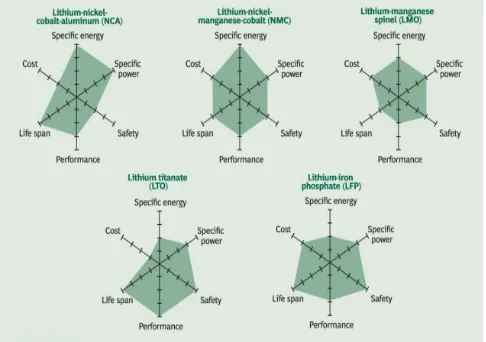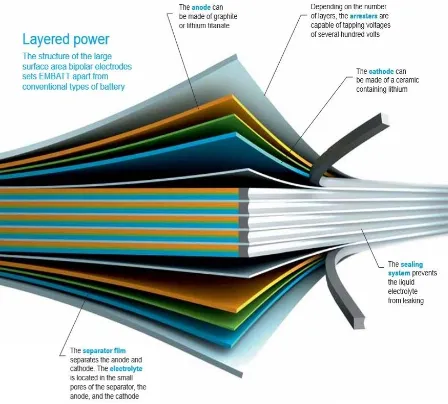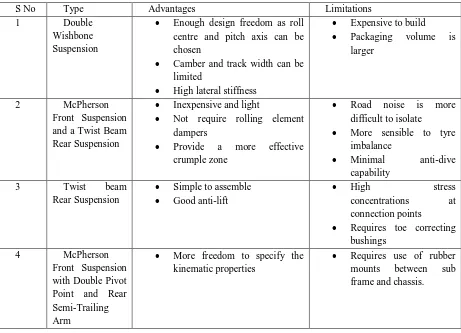Formulation for Battery Electric Vehicle (BEV)
Range & Structure of EMBATT Bipolar
Battery
Ibraheem Raza Khan1, Mayur Kailas Takalkar2
Abstract: In a world where environment protection and energy conservation are growing concerns, the development of electric
and hybrid vehicles (EV/HEV) has taken on an accelerated pace. The dream of having commercially viable electric/hybrid vehicles is becoming a reality. EVs and HEVs are gradually available in the market. This study reviews the present status of electric and hybrid vehicles worldwide, with emphasis on the engineering and technologies. The paper also includes a view on the latest development on batteries with high charge storage & vehicle chassis, suspension, body with embedded battery.
Keywords: Lithium ions Battery, Battery Electric Vehicle, EMBATT Bipolar Battery, EV-(Suspension, chassis, body)
I. INTRODUCTION
Battery electric passenger cars have a very long history, but they have failed to gain any significant market share, a short period at the beginning of the 20th century aside. At the beginning of the 1970’s with the oil crisis and increasing worries about air pollution the electric car gained interest again. With the advent of mobile phones, laptop computers and cordless power tools in the 1990’s battery technology developed rapidly. With high charge capacity the battery improved the range of vehicle and made the EV more popular among the masses. In the study we first look into the history of EV followed by the basic requirement from a Battery which is used in a Battery Electric Vehicle. Then formulation of petrol equivalent battery is discussed. Followed by chassis for Electric Vehicle and Body for EV.
A. Electric Vehicle (Ev) History
The first electric vehicle (EV) was built between 1832 and 1839; the exact year is not known, in Scotland by Robert Anderson, who created the first crude electric carriage. It was not until 1895, after A.L. Ryker built an electric tricycle and William Morrison built a six passenger wagon, that America paid attention to the electric vehicle. In 1902 Wood created the Electric Phaeton, which was more than an electrified horseless carriage and surrey. “The Phaeton had a range of 18 miles, a top speed of 14 mph and cost $2,000”.(Deffke, 2013) The decline in use and production of the electric vehicle occurred in the 1920s. Causes of the decline in production include: a better road system, reduced price of gasoline by the discovery of the Texas crude oil, invention of the electric starter, and the mass production of the internal combustion engine vehicles. By 1935, electric vehicles completely disappeared. In the 1960s and 1970s electric vehicles reappeared because internal combustion vehicles were creating an unhealthy environment for the people in America at that time.
B. Parameters for Batteries used in Electric Vehicle
1) Life span. Most EV batteries are guaranteed for 8 years or 160,000km (100,000 miles). Hot climates accelerate capacity loss; insufficient information is available about how batteries age under different climates and usage patterns.
2) Safety. Concerns arise if the battery is misused and is kept beyond its designated age. Similar fears occurred 150 years ago when steam boilers exploded and gasoline tanks burst. A carefully designed BMS assures that the battery operates within a safe working range.
3) Cost. This presents a major drawback as the battery carries the cost of a small car powered by an ICE. BMS, battery cooling, heating and the eight-year warranty add to the cost.
4) Performance. Unlike an ICE that works over a wide temperature range, batteries are sensitive to heat and cold and require climate control. Heat reduces the life, and cold lowers the performance temporarily. The battery also heats and cools the cabin.
6) Specific power. The electric propulsion system has better torque with the same horsepower than the ICE. This is reflected in excellent acceleration.(Young, 2013)
C. Equivalent Petrol Tank Battery Capacity
The amount of energy which is carried in the vehicle is still small compared to an ICE vehicle resulting in a limited range in order to get the same energy at the wheels the required energy from the battery in kWh is about twice the required amount of petrol expressed in litres. This can be used in an empirical formula to calculate the equivalent petrol tank volume for a given battery capacity:
, =
0.8∗ [ ℎ]
2
So if a nominal battery capacity Cbatt of 16 kWh is specified, the equivalent petrol tank volume is 6.4 litres. In case of 24 kWh the equivalent volume is 9.6 litres. This rule of thumb can be useful when making a first estimate on the achievable range of a battery electric vehicle.
The force Fx required to move the vehicle with a certain constant velocity v on a level road equals
=1
2 +
with ρ air density, A the frontal area, Cd aerodynamic drag coefficient, m mass of the vehicle including passengers and cargo, ‘g’ gravitational constant and frr the tyre rolling resistance coefficient. The efficiency of the inverter, motor, reduction and drive shafts have to be taken into account to calculate the required DC power usage. A constant overall efficiency ηd is assumed. Furthermore there may be auxiliary systems in the vehicle with a constant power usage Paux, independent from the forward velocity. The required power which has to be delivered by the battery then becomes:
= 1 1
2 + +
The DC energy usage of an electric vehicle is often expressed in the units Wh/km, so a certain amount of energy per kilometre driven. As 1 Wh/km is equal to 3.6 Ws/m or 3.6 N, it actually represents a force. The following expression can be derived for the energy usage per distance travelled:
= 1 1
2 + +
Vehicle range knowing the energy usage per distance travelled (4) and the available battery capacity, the constant speed range r can be calculated:
= ∗
+ +
Cbatt equals the battery capacity and ηbatt the battery utilisation factor.(Besselink, 2010)
D. The lithium-ion battery
“Lithium-ion battery” is the generic term for various different battery types. They use different electrode materials but they are all based on the idea that lithium ions, dissolved in the electrolyte, migrate between the electrodes during charging and discharge.
E. The cell elements
Cathode The cathode is the positive electrode (terminal). It is made of an aluminium foil, which is coated in different materials (known as “active materials”) depending on the battery type. The active materials can be made, for example, of lithium metal oxides (LiMeO4) or lithium metal phosphates (LiMePO4).
Anode The anode is the negative electrode. It is made of a copper foil, usually coated in graphite.
Electrolyte The electrolyte is the substance in which the lithium ions are dissolved and migrate back and forth from the cathode to the anode. It is normally a liquid, organic solvent but it can also be made of (synthetic) polymer or ceramic material.(K., 2015) Separator The separator is made of a porous material, often a plastic or fine ceramic material, which only allows the positive lithium ions to pass and blocks the electrons’ path. By doing this, it separates the electrodes mechanically and electrically, thus preventing short circuiting.
Voltage is applied to the electrodes in order to charge the battery. In the cathode, positive lithium ions and negative electrons break free from the lithium metal oxides. The electrons flow to the anode via the outer circuit. The lithium ions migrate through the electrolyte to the anode, where they become embedded in the gaps in the graphite layer (in a process known as “intercalation”). The lithium ions pick up the electron again and remain in the interlayer in the form of metal.
Figure 1- Charging and Discharging of Li-ion Battery
Lithium-ion battery has various combinations of Li and ions. The selection of the best suitable battery in accordance with the utility is based on cost, specific energy, specific power, life span, performance, safety.(Batteries foe Electric Cars Challenges,
Opportunities and the Outlook to 2020 by The Boston Consulting Group, 2010)
[image:4.612.70.556.365.707.2]G. Embatt Bipolar Battery: New Battery Design For Higher Energy Density
[image:5.612.89.537.198.602.2]The EMBATT bipolar battery consists of stacked cells, in which the current collector of the negative electrode of one cell is in contact with the positive electrode of the next cell. Thus, two electrochemical cells connected in series share one current collector – one side of the bipolar electrode serves as the anode in one cell and the other side as the cathode in the next cell.(Wolter, 2015) Through this simple stacking of cells, the bipolar battery design does away with complex cell packaging and delivers a stack voltage resulting from the number of single cells in the stack. The advantages of this design are numerous: low internal resistance in the stack, the option to use very large electrode areas, and elimination of the need for extensive cell connections as are found in conventional battery systems. The EMBATT design thus transfers the high energy density from the cell level directly to the battery system.
Figure 3- EMBATT Layered Power
H. Chassis & Suspension
Table 1- Various types of Suspension Available for BEV, their advantages and limitation.
S No Type Advantages Limitations
1 Double
Wishbone Suspension
Enough design freedom as roll centre and pitch axis can be chosen
Camber and track width can be limited
High lateral stiffness
Expensive to build Packaging volume is
larger
2 McPherson Front Suspension and a Twist Beam Rear Suspension
Inexpensive and light
Not require rolling element dampers
Provide a more effective crumple zone
Road noise is more difficult to isolate
More sensible to tyre imbalance
Minimal anti-dive capability
3 Twist beam
Rear Suspension
Simple to assemble Good anti-lift
High stress
concentrations at connection points
Requires toe correcting bushings
4 McPherson Front Suspension with Double Pivot Point and Rear Semi-Trailing Arm
More freedom to specify the kinematic properties
Requires use of rubber mounts between sub frame and chassis.
The range of the vehicle is a linear function of the battery capacity, meaning that with double battery capacity, the range is doubled if the rest of the parameters are kept constant. Recovery of electrical energy by using the electrical motors generators can increase the range from 18% to 29%. Adversely, addition of electrical consumers such as cooling systems, power electronics, heating, air conditioning, infotainment, headlights, wipers and such reduce the mileage range considerably, up to 40 %.
I. Body
Electrical vehicles allow designers to have more freedom in the design of the vehicle’s body since there are certain characteristics than can differ from a typical combustion vehicle. The most distinctive constraint left behind is the frontal overhang, which can be much shorter than in conventional vehicles. This permits an increase in the wheelbase which in turn has a direct positive effect in the interior room available. The shorter overhang also has influence on the crashworthiness and safety performance. All of this is achieved because of the smaller size of the components compared to a regular combustion vehicle.
Use of lightweight materials is fundamental for an EV to increase performance and range. Clever use of materials also influences dynamic performance and crash absorption. The most common approach is to add more resistant and light materials, combined in different parts of the body and chassis, permitting the designers and engineers to reinforce the most critical parts while using less expensive, softer and lighter materials on the parts that are not load intensive.
II. CONCLUSION
Although much progress has been over the past decades, battery electric vehicles are still somewhat hampered by a heavy energy storage device with limited capacity and relatively slow recharging capabilities. Given these limitations an attempt has been made to design and realise a battery electric vehicle which could appeal to a broad audience. A vehicle with high travel range in a single charge, fast charging and smart interactive systems for accurate and efficient usage of energy is required. With development of high charge capacity battery, upgraded vehicle chassis, suspension, body design and use of high strength light material the future for Battery Electric Vehicle is bright.
REFERNCES
[1] U. Deffke, “Electric Mobility – Rethinking the Car,” in IDEAS INNOVATION PROSPERITY, Niestetal, Federal Ministry of Education and Research (BMBF) Department for Electronic Systems and Electric Mobility 53170 Bonn, 2013, pp. 5-17.
[2] K. Young, “Electric Vehicle Battery Technologies,” Springer, vol. 11, pp. 3-6, 2013.
[3] I. Besselink, “Design of an efficient, low weight battery electric vehicle based on a VW Lupo 3L,” in The 25th World Battery, Hybrid and Fuel Cell Electric Vehicle Symposium & Exhibition , Shenzhen, China, 2010.
[4] P. K. S. K., “Design and Development of Electrical Car,” International Journal of Emerging Technology and Advanced Engineering , vol. 5, no. 4, pp. 239-241, 2015.
[5] Batteries foe Electric Cars Challenges, Opportunities and the Outlook to 2020 by The Boston Consulting Group, 2010.
[6] Z. Taufik, “Electric car chassis design and analysis by using CATIA V5 R19,” IOSR Journal of Mechanical and Civil Engineering (IOSR-JMCE) , vol. 11, no. 4, pp. 56-59, 2014


